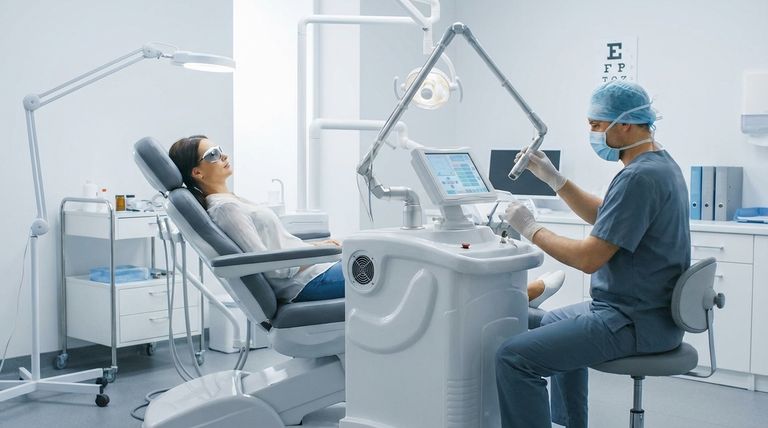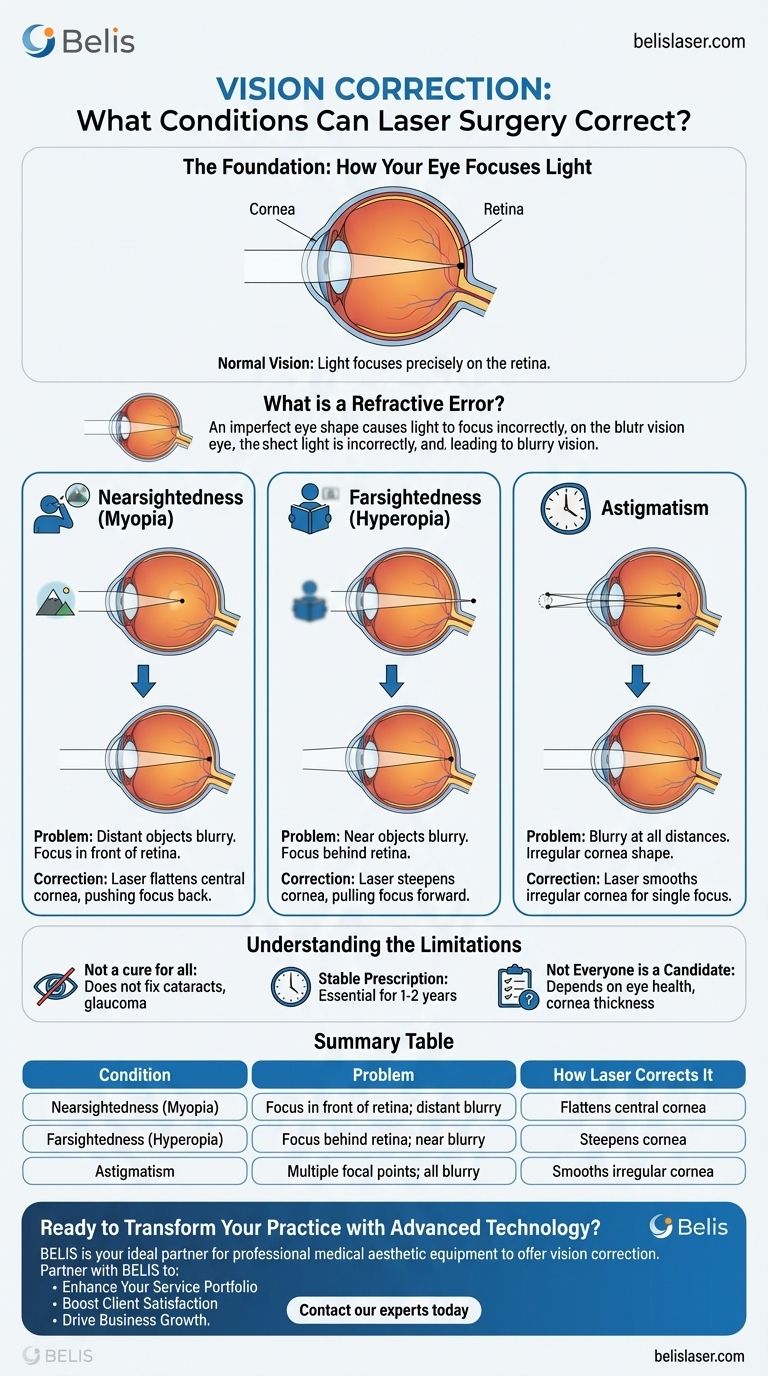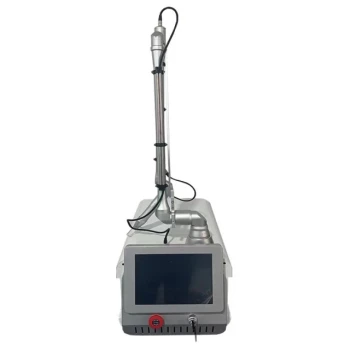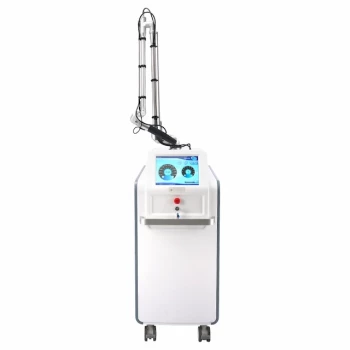At its core, laser eye surgery is designed to correct three primary types of vision problems known as refractive errors. These conditions are nearsightedness (myopia), farsightedness (hyperopia), and astigmatism. The surgery works by permanently changing the shape of the cornea to correct the way your eye focuses light.
The fundamental purpose of laser vision correction is not simply to eliminate glasses or contacts, but to physically reshape your eye's cornea. By precisely altering its curvature, the laser corrects the underlying refractive error that causes light to focus improperly on your retina.

The Foundation: How Your Eye Focuses Light
The Role of the Cornea and Retina
To understand how laser surgery works, think of your eye as a camera. The cornea, the clear, dome-shaped front surface of your eye, acts as the primary, most powerful lens. It bends incoming light.
The light then passes through the pupil and the inner lens, ultimately needing to come to a sharp focal point on the retina—the light-sensitive tissue at the back of your eye, which acts like the camera's sensor or film.
What is a Refractive Error?
A "refractive error" is a technical term for a simple problem: the shape of your eye does not bend light correctly. This causes the focal point to land either in front of or behind the retina, resulting in a blurry image.
These errors are not a disease, but rather a mechanical imperfection in the eye's focusing system. Laser surgery is a mechanical solution to this problem.
How Laser Surgery Corrects Each Condition
Correcting Nearsightedness (Myopia)
With myopia, distant objects appear blurry because the eye focuses images in front of the retina instead of directly on it. This typically happens because the eyeball is slightly too long or the cornea is too steeply curved.
To fix this, the laser flattens the central part of the cornea. This reduces the cornea's focusing power, effectively pushing the focal point backward until it lands precisely on the retina.
Correcting Farsightedness (Hyperopia)
With hyperopia, near objects appear blurry because the eye focuses images behind the retina. This occurs if the eyeball is slightly too short or the cornea is too flat.
To correct this, the laser reshapes the cornea to be steeper. This increases the cornea's focusing power, pulling the focal point forward onto the retina for clear vision.
Correcting Astigmatism
Astigmatism causes blurry vision at all distances because the cornea is shaped more like a football than a sphere. This irregular shape creates multiple focal points, preventing the eye from ever forming a single, sharp image.
The laser corrects astigmatism by smoothing the irregular cornea into a more uniform, spherical shape. This allows light to pass through and form a single, clear focal point on the retina.
Understanding the Limitations
It Is Not a Cure for All Eye Problems
Laser surgery is highly effective for refractive errors, but it does not address other common eye conditions. It cannot fix problems related to the lens (like cataracts) or the optic nerve (like glaucoma).
A Stable Prescription is Essential
A good candidate for laser surgery must have a stable eye prescription for at least one to two years. The procedure makes a permanent change to the cornea, so if your eyes are still naturally changing, the benefits of the surgery will diminish over time.
Not Everyone is a Candidate
Your eligibility depends heavily on the health and structure of your eyes. Factors like having corneas that are too thin, suffering from chronic dry eye, or having certain autoimmune diseases may make you a poor candidate for the procedure. A thorough pre-operative exam is non-negotiable.
Making the Right Choice for Your Vision
The type of correction you need is directly tied to the specific refractive error you have.
- If your primary issue is seeing distant objects (nearsightedness): The laser will be used to slightly flatten your cornea, moving the point of focus back onto your retina.
- If your primary issue is seeing near objects (farsightedness): The laser will steepen your cornea's curvature, moving the point of focus forward onto your retina.
- If your vision is generally blurry or distorted at all distances (astigmatism): The laser will smooth out your cornea's irregular shape, creating a single, clear point of focus.
Understanding this mechanism is the first step toward making an informed decision about your vision.
Summary Table:
| Condition | Problem | How Laser Corrects It |
|---|---|---|
| Nearsightedness (Myopia) | Eye focuses light in front of the retina; distant objects are blurry. | Flattens the central cornea to push the focal point back onto the retina. |
| Farsightedness (Hyperopia) | Eye focuses light behind the retina; near objects are blurry. | Steepens the cornea to pull the focal point forward onto the retina. |
| Astigmatism | Irregularly shaped cornea creates multiple focal points; vision is blurry at all distances. | Smooths the cornea into a uniform, spherical shape for a single, clear focal point. |
Ready to Transform Your Vision with Advanced Technology?
If you're a medical aesthetics clinic or premium beauty salon looking to expand your services with safe, effective, and cutting-edge treatments, BELIS is your ideal partner. We specialize in providing professional medical aesthetic equipment, empowering you to offer life-changing procedures like vision correction with confidence and precision.
Partner with BELIS to:
- Enhance Your Service Portfolio with trusted, state-of-the-art technology.
- Boost Client Satisfaction by delivering exceptional, proven results.
- Drive Business Growth by tapping into the high-demand aesthetic medicine market.
Contact our experts today to discover the right equipment for your practice and learn how we can help you achieve new levels of success.
Visual Guide

Related Products
- Fractional CO2 Laser Machine for Skin Treatment
- Fractional CO2 Laser Machine for Skin Treatment
- Pico Laser Tattoo Removal Machine Picosure Picosecond Laser Machine
- Pico Picosecond Laser Machine for Tattoo Removal Picosure Pico Laser
- Hydrofacial Machine with Facial Skin Analyzer and Skin Tester
People Also Ask
- How does fractional CO2 laser work? The Science Behind Powerful Skin Renewal
- Why am I not seeing results after a CO2 laser? Your Patience is the Key to Long-Term Skin Rejuvenation
- Who is not a good candidate for CO2 laser? Avoid Complications and Ensure Safe Treatment
- What is a CO2 fractional laser good for? Dramatic Skin Rejuvenation for Wrinkles & Scars
- What is a fractional CO2 laser machine used for? A Guide to Advanced Skin Resurfacing



















